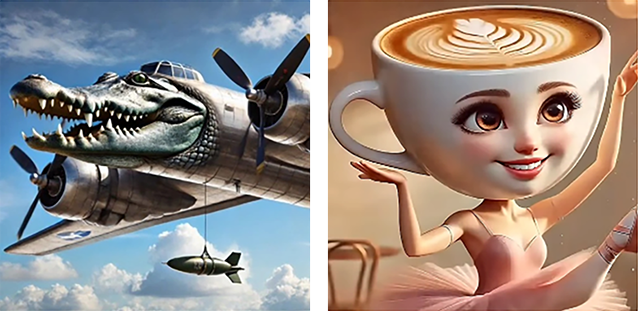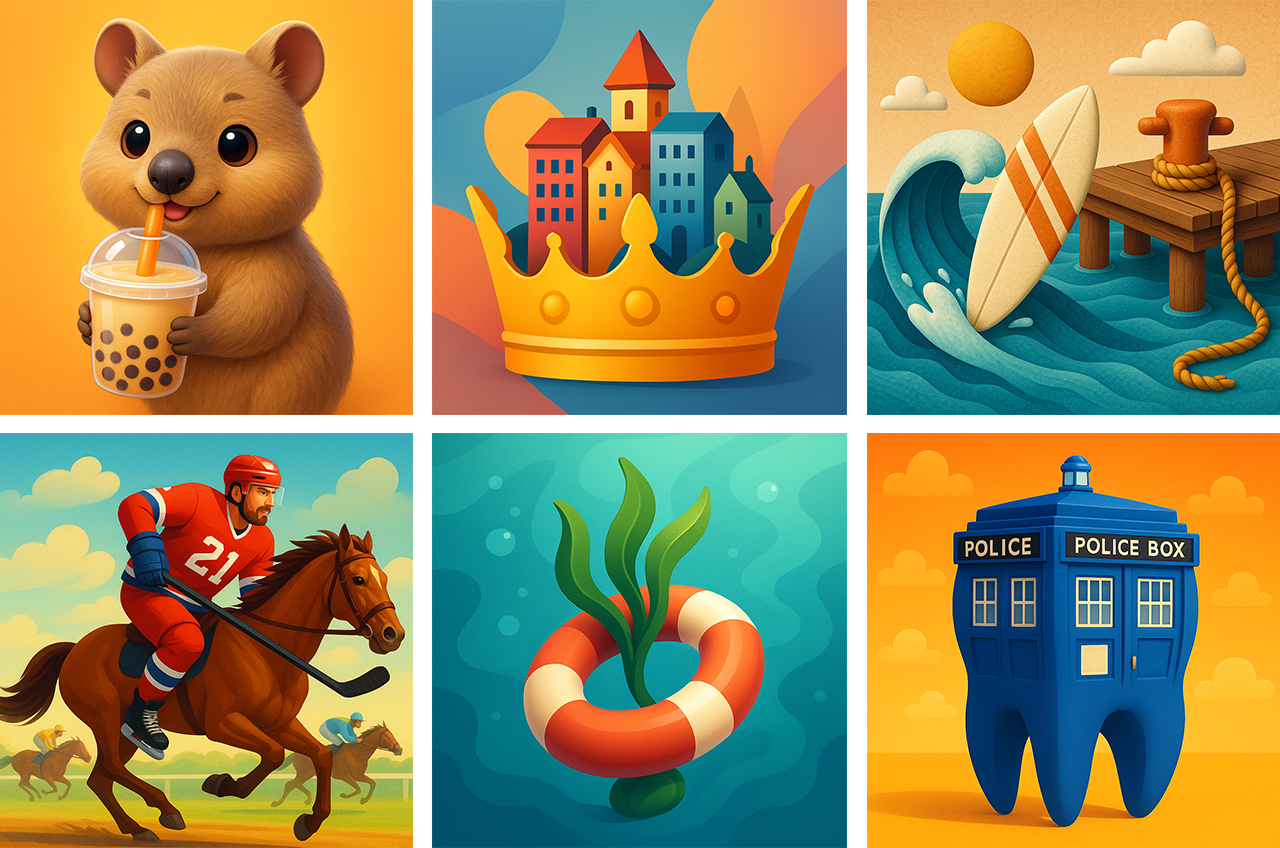“No eyes, please!” – How we taught AI to be a game designer
“Artificial intelligence won’t help if there are problems with the natural one”.
Folk wisdom
It all started during a perfectly ordinary weekly meeting at a game development studio. The marketing team suggested adding visuals in the “Italian Brainrot” style to one of our casual games. As examples, the slides showed Bombardiro Crocodilo and Ballerina Cappuccina.

While the marketing team was busy discussing with the developers the technical details of integrating the new “brainrot” visuals into the game, the lead designer wondered why Ballerina Cappuccina and not, say, Ballerina Sardina... Ten minutes and one lively brainstorming session later, we had the concept for a brand-new casual game.
The idea behind the game
The gameplay turned out to be pretty simple: the player is shown an image that visually combines two words into one object. For example: bat – mat, time – crime, box – paradox… The player’s goal is to guess the pair of words illustrated in the picture.
To make the guessing process more structured, we added a few key rules:
- The two words must rhyme.
- On the challenge card, both words are represented by underscores, so players can see how many letters each word contains.
We also decided to label some levels as “hard” – those involving abstract concepts such as emotions or phenomena that are difficult to visualize. For instance, the pair knight – plight required much more creativity to depict, often resulting in deeply metaphorical or even surreal illustrations.

The main challenge in developing the game was that most of the puzzles could be guessed in under a minute. That meant we needed to create HUNDREDS of unique, visually engaging images to make the game truly playable.
That’s when the idea for a new kind of project was born – one that would combine the creative power of artificial intelligence with the professional expertise of game developers. The game became a collaborative project between QuData – AI development company and Absolutist – gamedev studio, with each side contributing its unique strengths:
- The Absolutist team handled the game mechanics, design, and gameplay implementation.
- The QuData team focused on exploring and applying generative AI models to create content, prompts, and visual concepts.
Together, we combined technological expertise and a creative approach, turning a simple idea into a full-fledged game project.
Choosing the right tool for level design
The level generation process was divided into two main parts:
- Come up with fun and quirky rhyming word pairs
- Generate matching illustrations for each pair
To tackle the first challenge, we appointed ChatGPT-4o as our main creative engine. Despite its shortcomings, it seemed to handle the task surprisingly well – producing hundreds of rhyming word combinations.The key advantages of using ChatGPT included:
- The ability to generate rhymes in multiple languages
- A large list of rhyming pairs (over 700 unique combinations)
- The flexibility to refine and adjust word pairs during iteration
For the second task – image generation – the team initially planned to use popular AI image tools. But after a few test runs, we discovered that ChatGPT-4o could also produce visual results that fit our goals remarkably well. The following factors worked in its favor:
- The 1024×1024 pixel limit was ideal for our square-format game cards.
- The occasional AI “mistakes” (compared to other image generators) gave the images a unique “brainrot” aesthetic that perfectly matched the game’s vibe.
- Even the unpredictable style shifts between generations added diversity and kept the visuals interesting.
Working with prompts for rhymes
We had no illusions that ChatGPT would instantly generate a thousand clever rhyming pairs in one go. In reality, the best we could get from it was around 700 word pairs, which then had to be manually reviewed and filtered by our designers (native speakers).
Provide two well-known English words that rhyme perfectly. Give 20 examples.
When asked for 20-30 pairs, ChatGPT handled the task reasonably well. But in the next iterations the model could start repeating results or producing combinations that made little sense – even by brainrot standards. We also noticed that the AI performed better in smaller batches (10-20 pairs per prompt) rather than trying to produce a massive list of 100+ at once. Occasionally, it helped to use ChatGPT’s own follow-up suggestions like “generate more examples on this theme.”
At the next stage, we discovered that ChatGPT’s understanding of rhyme is… quite flexible. It did indeed generate about 700 pairs – but not all of them could be considered real rhymes. For instance, here are a few of the “successful” examples, according to ChatGPT:
gull – bull
sardina – balerina
sushi – plushie
igloo – canoe
From a phonetic standpoint, only a portion of these actually rhymed. Many others needed manual correction or replacement. In addition, we filtered out pairs with negative or inappropriate connotations, such as cat – brat
The outcome
Considering all factors, we concluded that ChatGPT contributed to roughly 10% of the rhyme generation process. 90% of the 1,000 final rhyme pairs used in the game were created, verified, and polished by our designers.
Examples of approved combinations:
coffee – trophy
riddle – needle
jam – gem
ocean – potion
Working with prompts for image generation
When it was time to move from words to visuals, we decided to rely entirely on ChatGPT’s creativity for this task. Imagining and illustrating several hundred pairs of seemingly unrelated concepts would be nearly impossible for a human. For an AI, however, it’s the perfect creative challenge.
That said, ChatGPT didn’t always get it right on the first try. On average, every second image had to be regenerated twice, and every fifth – more than three times. The prompts for image generation were constantly refined – evolving from short instructions to detailed descriptions with clarifications and restrictions.
Create an image that shows (A) combined with (B). It should be a single object consisting of both concepts. The background should be abstract, and the image should be square. Do not use text or captions to label the concept. The style should resemble pseudo-3D vector graphics. Do not use outlines in the image. The image must look visually appealing. Do not draw eyes or smiles on the object.
Most prompt modifications were related to clarifications. Despite its impressive experience with image generation, ChatGPT often ignored the given rules: adding “eyes” or “smiles” to inanimate objects, or labeling what it had drawn directly on the picture. At times, we literally had to “explain” the meaning of words to the AI, as it tended to interpret even obvious things in its own way.
It was also common for the model to confuse contexts and carry over visual elements from previous prompts. As a result, every tenth image could contain parts of previous associations.
Another persistent challenge was anatomy – still a weak point for AI image generators. The model continued to make mistakes with the number of limbs or fingers, often “merging” or duplicating body parts and creating unnatural joints or distortions. For example, while generating an image of a sloth, the model produced a three-legged animal.

We tried to fix the issue with a clarifying prompt:
In this picture, the sloth has three limbs holding onto a branch (the sloth is hanging from the branch, clinging to it), but the sloth should have four limbs – one hind limb is missing. Please add it.
It seemed like a simple request – yet the result turned out… even worse. ChatGPT added extra limbs, just not the right one.

In the end, the image was corrected only after our designer stepped in and manually redrew the missing limb.

Beyond creative challenges, we also faced technical ones: ChatGPT’s limit of around 200 image generations per month significantly slowed down production. We had to carefully plan the task queue and distribute requests across team members to keep the workflow steady.
The outcome
Despite all the difficulties, 100% of the game’s 1,000 levels were generated by ChatGPT. Only a few dozen images required minor touch-ups from our artists to correct small visual inaccuracies.
Examples of approved images

Summary
This project became a prime example of how artificial intelligence and humans can complement each other in creative processes. It is entirely possible to use AI as the lead level designer for an abstract casual game.
The game mechanics allow us to turn AI’s current shortcomings – spontaneity, illogical choices, and unusual associations – into artistic strengths. Where a human artist might search for inspiration, the neural network already generates unexpected ideas that set the tone for the entire game.
You can test the results of this collaboration between AI and our game development team in the free mobile game Guess Mess!
Absolutist team



